Ethiopia
Ethiopia, in long form the Federal Democratic Republic of Ethiopia is a state of the Horn of Africa. Ethiopia has common borders with Eritrea (former province) to the north, Somalia to the east-southeast, Sudan to the northwest, South Sudan to the west-southwest, the Kenya to the south and the Republic of Djibouti to the northeast. Since Eritrea’s independence in 1993, Ethiopia has had no access to the sea. The country is one of the 5 richest countries in Africa. Second country in Africa by its population, behind Nigeria, with 108,386,391 inhabitants, Ethiopia is the ninth country on the continent by its area (1,127,127 km2). Mainly made up of high plateaus, extending from the Danakil depression at −120 m to the snow-capped peaks of Mount Ras Dashan at 4,543 m, the country has a very diverse environment crossed by six climatic zones. The capital Addis Ababa, located at 2,400 m above sea level, is the fifth highest capital in the world.
Considered one of the cradles of humanity, Ethiopia is, along with Chad, Morocco and Kenya, one of the countries where the oldest hominids are found. Lucy was discovered there in 1974 and, in 2003, the oldest specimens of Homo sapiens. Within Africa, Ethiopia is characterized as one of the countries to have retained its sovereignty during the division of Africa in the 19th century: because of this, its colors often symbolize Africa and were adopted by several other African states, in different configurations. Ethiopia, today constitutionally secular with, is a country where many beliefs coexist. After Armenia, it is the second oldest Christian nation in the world, Christianity being established there around the year 330. Today there are Eastern Orthodox, Catholics and Protestants. In addition, a third of its inhabitants are Muslim and religious minorities such as the Jewish Beta Israel or animists also live there. Internationally, Ethiopia signed the United Nations declaration in 1942 and became one of the 51 founding member states of the United Nations. Addis Ababa is today the seat of the Economic Commission for Africa (ECA) and the African Union.
Ethiopia’s history
Independent states have been identified over parts of present-day Ethiopia for nearly 3,000 years. Around the eighth century BC. J. – C., one notes the formation of the kingdom D’mt, followed by various other entities, without the continuities being always clear: the kingdom of Aksum, the kingdoms zagwés. Around 1270 the Solomonid dynasty was formed, which continued in various forms until the Ethiopian Empire, the Provisional Military Government of Socialist Ethiopia, the Democratic People’s Republic of Ethiopia and the present Federal Democratic Republic of Ethiopia.
Prehistory and Antiquity
Considered one of the cradles of humanity, Ethiopia is one of the oldest areas of human settlement. The first traces of hominids date back 3 or 4 million years. The appearance of Homo erectus and Homo sapiens in the region is between 1.7 million years and 200,000 years before our era. There is relatively little data on Ethiopia during Antiquity which seems to have been part of the country of Punt (-3000 – -1000).
The mythical king of the Ethiopians, people quoted by Homer and located at the archaic time in Africa, in the south of Egypt it is Memnon (in ancient Greek Μέμνων / Mémnôn, “that which holds good”) living towards. 1250 BC AD The D’mt kingdom (VIII- V centuries BC) is generally regarded as the first organized form of a State in Ethiopia. Very few archaeological traces have survived from this kingdom which would have had very close relations with the Sabean kingdom in Yemen. Some modern historians however consider that the D’mt civilization is indigenous and that it would have suffered little Sabean influence; others believe that it would be a mixture between the dominant Sabean culture and an indigenous culture. After the fall of the kingdom of D’mt in the fifth century BC. BC, various kingdoms dominated the region until the emergence in the first century BC. AD, from the kingdom of Aksum, the first important empire in Ethiopian history.
The Ethiopian Middle Ages
The Zagwés and the establishment of the Solomonids
Around 990, the Aksumite kingdom collapsed definitively. Due to the progression of Islam from the coasts, the Christians are pushed back towards the interior of the grounds and various contenders compete for the control of the center of the paysh . Around 1140, the Zagwés of Lasta, come to power . They initially dominate the northern part of their province but from the beginning of the 13th century, they extend their control over the Tigray, the Begemeder and the current Welloh. The feudal structure of the Empire offers to the regional lords a relative autonomy The most famous sovereign is Gebre Mesqel who orders the construction of a set of churches carved out of the rock. Support from the Ethiopian Orthodox Church ensures the Zagwés their supremacy.
In 1270, the last Zagwe ruler, Yetbarek, was overthrown by Yekouno Amlak. The coming to power of the latter marks the establishment of the Solomonid dynasty which symbolically endures almost continuously until 1974, without there being family continuity. For almost three centuries, the country lived a period of cultural, administrative development, territorial extension and wars against the Moslem sultanates close to the Christian kingdomsh, although this divide covers the leaders more than the inhabitants. This phase of Ethiopian history is sometimes nicknamed the “golden age of the Solomonid dynasty”. Amda Syon Ier leads the first great territorial conquests during the thirty years of his reign (1314-1344); an expansion consolidated by Dawit I and Yeshaq I from the end of the 14th to the beginning of the 15th. In addition to its military successes, Ethiopia is experiencing a phase of development of Orthodox Christianity and national literature. In this area Zara Yaqob seems to be the emblematic sovereign. During his reign from 1436 to 1468, he converted the inhabitants of Damot and Godjam and participated in theological debatesh. He is also an author, whose best known work is the Metsehafe Berhan (Book of Light). During these centuries, various administrative and financial reforms reorganized the Empire. One of the characteristic elements of this period is the continuous displacement of the court, a practice used by the majority of sovereigns and which allows them to mark their domination over regional officials, to ensure their control of the territoryh and to distribute the predation they exercise on resources.
War, unrest and destabilization of imperial authority
This phase of prosperity ends at the beginning of the 16th century, under Lebne Dengel. Economic unrest and the strong demographic surge in the Islamic sultanates led, in 1527, to the outbreak of a war between Muslim forces led by Ahmed Ibn Ibrahim Al-Ghazi, known as Ahmed “Gragne” (left-handed in Amharic) and the ethiopien Christian empireh. Supported by the Ottomans, Ahmed’s troops won a series of victories and in 1535, the Ethiopian Empire seemed to be on the verge of collapseh. Nevertheless, the course of the conflict will change from 1541, with the arrival of the Portuguese to whom Lebne Dengel appealed. On February 21, 1543, at the end of the Battle of Wayna Daga, Ahmed was killed and his army defeated, leaving behind a country in ruins and weakened. Faced with the weakness of the Empire, the Oromos will migrate from Balé and Sidamo, to the north, center and west of Ethiopia; these population movements will last three decades from 1550 to 1580. The fragility of Ethiopia encouraged the arrival of the Jesuits like Balthazar Telles. During the second half of the sixteenth century, they managed to impose Catholicism on the sovereign Sousnéyos who converted in 1621. The ensuing protests turned into a real civil war and Sousnéyos abdicated on June 14, 1632 of his son Fasilidesh. Thus ended in blood an interesting parenthesis of attempt to westernize an African country, generally overlooked in relation to the enterprises carried out and successful by the Society of Jesus in Latin America or in China . Nearly a century of European presence (Spanish, Portuguese and Italians mainly) which influenced this Nation which made dream the West even if only with regard to the legend of the Priest Jean.
In 1632, the new sovereign founded Gonder where he built a château. The new city became the capital of the country as well as an important religious and commercial center. The year 1632 marks the beginning of the Gonderian period which ends in 1769 and during which the doctrinal divisions of the Church, the breakthrough of Islam and the fight against the Oromo offensives lead to an announced collapse. During in the first half of the eighteenth century, economic stagnation and the destabilization of imperial authority prompted local lords to take ever more power. In January 1769, with the murder of Iyoas Ier begins the Zemene Mesafent (“Era of the Princes”). Until 1855, a series of sovereigns with limited powers reign at Gonder; the real holders of power are the mayors of palaces and the local lords. The Zemene Mesafent constitutes a phase of economic stagnation, the innovations being dissuaded by the incessant wars. The Ethiopian population suffered particularly during this period and during the 1830s, an old prophecy re-emerged according to which a sovereign will come to power, will establish a reign justly and ensure peace in the country. By the middle of the 19th century, the military exploits of a young Kassa Hailou seemed to herald the advent of this long-awaited monarch.
Centralization and independence: building the modern Ethiopian state
The Ethiopian Empire faced with foreign threats
The same year, the negwa of Shewa was proclaimed negusse negest under the name of Menelik II. The third great sovereign of this end of the century continues the process of expansion, unification and modernization of the country, while facing European threats. He signed with Italy the Wouchalé treaty, supposed to ensure peace and friendship between the two countries. However, the Ethiopians refuse to recognize the interpretation of the text by the Italians (who use it to notify a protectorate according to the procedure defined in Berlin) and denounce it in 1893. This conflict leads to a war in 1895, which ends by the battle of Adoua during which more than 100,000 Ethiopians crushed the Italian forces in March 1896. This success guaranteed the Empire its independence and the international recognition of Ethiopian sovereignty, even if some authors then mentioned a “semi -sovereignty ”.
Ethiopia from the beginning of the 20th century to the fall of the Empire
At the beginning of the 20th century, during the years 1910-1920, two sovereigns with very different personalities followed one another: Ledj Eyassou and Zewditou Ire. The first is officially in power from 1913 to 1916, his brief reign is particularly agitated. coup d’état of September 27, 19 4:30 p.m. Zewditou Ire arrives on the imperial throne, his reign sees the emergence of Tafari Makonnen, appointed regent and prince during the coup d’Étath. During the 1920s, progressives and conservatives oppose Courh. The latter oppose the will to open up to the world that the former defend. In 1923, by making Ethiopia the first African country to join the League of Nations, Tafari won a victory.
During the 1920s, he led modernization policies in all areas, social as well, with the abolition of slavery, as economic and legal. This process continued under his reign which began on April 3, 1930, at following the death of Zewditou; Tafari was crowned on November 2, 1930 under the name of Haile Selassie I. A new Constitution, the first in Ethiopian history, was promulgated in 1931, many schools were built, the economy was reformed and political power centralized; everything is done to protect Ethiopia from a colonial invasion. This does not prevent the outbreak of a war with fascist Italy in 1935 which leads to an Ethiopian defeat and the start of an occupation partial of the country for five years during which a national resistance is organized. In 1941, year of the liberation, opens a new period named Addis Zemen (in French: New Era) following the Italian defeat before the forces Anglo-French in the north of the country, the Italians who occupied Addis Ababa having capitulated and the Belgian Public Force of the Congo, attacking in the south, having received the Italian capitulation from Asosa. Consequently, it was a question for Haïlé Sélassié of taking over the worksites opened at the beginning of his reign. The country then experienced a period of industrialization and economic growth, but also various troubles. Indeed, rebellions broke out in Tigray in 1943, as well as in Godjam, Balé, Ogaden and Eritrea during the years 1960. To these movements are added demonstrations against political power as well as strikes. In the context of the Cold War, when the policy of the Negus was rather favorable to the West, the Eastern European bloc supported the protest movement, taken in hand by a committee of soldiers called Derg, who succeeded in removing in September 1974 Haile Selassie I and to overthrow the oldest monarchy in the world.
Ethiopia from 1974 to the present day
The Derg revolution and regime
On September 12, 1974, Haile Selassie was deposed and arrested, former dignitaries were imprisoned, strikes and demonstrations were prohibited. The Derg, the military junta, began to take power. Students are sent to the provinces to carry out literacy campaigns and spread the new ideology, of Soviet inspiration. but many are victims of diseases and gangs by landowners, hostile to the new regime. Nevertheless, the literacy rate rose from 5% in 1974 to 35% in 1981, which earned Ethiopia recognition from UNESCO which awarded it its prize in 1980.
The state takes partial control of the economy, several companies are nationalized. In 1975, an agrarian reform was launched. The land is nationalized, farmers’ cooperatives are set up, land is distributed to those who did not have one with a size limit per farm. The Derg promises to make Ethiopia a plurinational state: “no more nationality will dominate the others”. It set up an Institute of Nationalities which brought together geographers, ethnologists and economists in order to better understand the characteristics of each ethnic group. Muslims are admitted as true Ethiopians for the first time in the history of the country, and three days of Muslim holidays are recognized by the state. Finally, a large single party was set up on a national and socialist basis. If the Derg initially succeeded in asserting its authority, the civil political parties demanded a transfer of power and the return of the military to the barracks. The two main opposition parties are MeisonNote and the Revolutionary People’s Party of Ethiopia (PRPE). The clashes between the second party and the regime degenerated and from the end of 1976 to the end of 1978, the country lived “two terrible years”. The confrontations are particularly brutal and the repression accentuates the radicalism of the regime. The families of the members of the PRPE are targeted and the participation of young schoolchildren alongside the PRPE leads the Derg to massacre entire classesfrom April 29 to May 1, 1977, nearly a thousand students and high school students are murdered after mobilizations students against the regime. This period of political violence, known as the Red Terror, left its mark on the Ethiopians, bringing them closer to other peoples of the Communist bloc. Murders are also common within the Derg, where rivalries between people give rise to arrests and shootings from 1977.
That same year 1977, the country faced an offensive from the Somali army which invaded the national territory in July. The Ogaden War is launched; with the support of the European communist countries and of Cuba, Ethiopia wins the conflict. During the civil war, the violence of the regime hit civilians hard and favored the separatists of Tegré and Eritrea who were advancing: in the North of country, the regime encounters real military difficulties. While the USSR, in the midst of perestroika and glasnost, is no longer able to support the regime, the end of the Derg seems to be approaching when the two main guerrilla movements, the Tigray People’s Liberation Front (FLPT) and The Popular Front for the Liberation of Eritrea (FPLE) coordinated their operations from the mid-1980s. A series of victories led the first movement to broaden its objectives within the coalition of the Revolutionary Democratic Front of the Ethiopian People (FDRPE ), supposed to liberate the whole country. On May 21, 1991, Mengistu Haile Mariam decided to flee the country and a week later, the FDRPE forces entered the capital. On May 28, 1991, the Derg regime fell and the date became a national holiday.
The 1994 constitution and subsequent development
From 1991 until 1995, the country was ruled by a transitional government responsible for leading Ethiopia to a democratic regime. In 1992, the Revolutionary Democratic Front of the Ethiopian People (FDRPE) won the first multi-party elections in the country’s history and prepared a new Constitution. The following year, the referendum for the independence of Eritrea, carried out in agreement with the FDRPE, saw the victory of the separatists. In 1994, the constituent assembly voted to ratify the new Constitution which entered into force in August 1995. The Federal Democratic Republic of Ethiopia was officially proclaimed. The transition took place quickly and in a relatively calm atmosphere. The FDRPE will nevertheless face some difficulties. In 1998, Eritrea invaded Ethiopia and launched a two-year war. The conflict killed more than 80,000 people and saw the victory of Ethiopian troops. Since then relations remain difficult between the two states. The central government is also facing two armed rebellions, the Oromo Liberation Front (FLO) and the National Front for the Liberation of the Ogaden (FNLO). The latter is also supported by the Union of Islamic Courts, an active movement in Somalia where Ethiopia intervened, in support of the official government of Mogadishu, from 2006 to 2009. Despite the constitution, the country is considered in fact as a police murderous state.
In 2005, the general elections saw the rise of opposition political parties, which won numerous seats in the national parliament and in the regional councils. However, they dispute these results, which allow the FDRPE to remain in power. Violent demonstrations erupt in Addis Ababa and several opponents are arrested. If the general elections of 2010 arouse the same passion with a turnout of 90%, the results do not confirm the trend of 2005. On the contrary, the FDRPE and its allies win almost all the seats in the lower house while that opposition is only necessary in two constituencies. This overwhelming 99% victory, contested by opponents, reinforces the presence of Meles Zenawi’s party throughout Ethiopia. Finally, these elections are distinguished from the previous ones by the calm and serene climate in which the process takes place. In 2011, a food crisis affected a large part of the Horn of Africa. On the night of August 20 to 21, 2012, Meles Zenawi died in full function after 21 years in power. In accordance with the Constitution (article 73), Haile Mariam Dessalegn is appointed as Prime Minister by the House of Peoples’ Representatives. The Omoros, the majority ethnic group with more than a third of the population, went into rebellion in November 2015. The Amharas, a quarter of the population, did the same in August 2016. The state of emergency was declared on October 9, 2016. Haile Mariam Dessalegn resigned in February 2018 to everyone’s surprise. On April 2, 2018, Abiy Ahmed succeeded him. This longtime politician is popular with the Omoros from which he came. From his inauguration speech, he reached out to Eritrea, calling for an end to the conflict that had been going on since the country’s independence in 1993. He also described the opposition parties as brothers and not as enemies. The internal situation and relations with neighboring countries have calmed down.
Ethiopia’s politics
Since the mid-1990s, the country has been in the process of democratization. The Revolutionary Democratic Front of the Ethiopian People (FDRPE) has won all elections since 1995. This coalition is dominated by the Tigray People’s Liberation Front, a party chaired by Meles Zenawi, Prime Minister of Ethiopia since 1995. Since the When FDRPE came to power, political life and, in general, Ethiopian society, were liberalized. The single party regime established under the Derg has been abolished and opposition political parties are legally authorized. On the security level, the government faced insurgencies in the Ogaden region, repressed in 2007-2008 as well as the rebellion of the Oromo Liberation Front. The main opposition coalition is the Forum for Democracy and Dialogue, nicknamed Medrek. It includes the Unity for Democracy and Justice party, nicknamed Andenet (“unity” in Amharic), founded in 2008 for the general elections of May 2010 and led by Bertoukan Mideksa. It includes the parties of the Coalition for Unity and Democracy which participated in the 2005 election. The May 2010 elections greatly strengthened the FDRPE. The debates revolved mainly around economic issues. If the government claims a positive balance sheet and strong annual growth, the opposition says that these are only statistical developments and not real changes. Since the end of 2015, important demonstrations against the power, of the main ethnic groups, Oromos and Amharas, have been repressed in the blood, causing 140 deaths then 100 deaths. The decisions of the government, dominated by the Tigray minority, are less and less accepted by these two ethnic groups. In 2016, the country is still described as having a very repressive policy towards journalists and press freedom, being one of the countries imprisoning the most journalists and carrying out significant censorship, with strong state control over media. On March 27, 2018, the coalition in power for almost 27 years appointed Abiy Ahmed as Prime Minister. This appointment is a great first for an Oromo, the majority but excluded from the highest offices in the modern history of the country.
Ethiopia’s economy
Natural resources
Covering over a million square kilometers, Ethiopia has 65% arable land. The 14 major or medium-sized rivers crossing the country also constitute immense water resources. In addition, its very rich herd of 27 million cattle, 24 million sheep and 18 million goats, places the country at the forefront of the continent and tenth globally. Deforestation increased considerably during the 20th century and constitutes a major environmental problem: forests only constituted 3% of the territory in 2007, compared to an estimate of 40% in the past century. However, reforestation efforts have helped reverse this trend since the figure rose to 9% in 2010. The geological resources are gold ($280.2 million in export revenue in 2010-11), natural gas, iron, tin, lignite and potassium. There are also gemstones (opal, topaz, olivine, corundum), rare metals (especially tantalum used in consumer electronics, for an income of 4 million in 2009-201079) and industrial minerals80. Ethiopia has 5 sedimentary basins potentially rich in hydrocarbons: the Ogaden basin, in Gambela, the Omo basin, Abay and in Tigré. Oil exploration in Ethiopia began in 2000 with the establishment of the American company Hunt Oil.
Since 2007, the government plans to extend the concessions in plateaus located in the center of the country83. In 2009, there were 11 companies present in the country. In terms of fossil fuels, the ministry expects a potential of 113 billion tonnes of natural gas and 253 billion tonnes of oil shales. To date Ethiopia belongs to the non-oil producing countries. These operations are the subject of strong tensions with the local populations, in particular the separatist movement of the Ogaden accusing the Ethiopian government of defending the implantation of these companies leading to massive deforestations of the oil zones, displacement of the nomadic populations and the destruction of a fragile ecological balance. In 2007, an attack on a Chinese oil company killed 74 people. Arabica coffee supports 12% of the population during the harvest period, which extends from October to February. The country is one of the major players in this market, of which it is the sixth largest exporter in the world, in particular for Arabica coffee, the most sought after on the major consumer markets. During the first six years of the decade of the 2010s, Ethiopia confirmed its place among the fifteen largest world coffee producers, in fifth position, but disappointed by a stagnation in its total coffee production.
Energy sector
The hydroelectric potential is estimated at 45,000 megawatts, 5,000 megawatts for geothermal energy, 300 million tonnes of coal, 15 to 20 million tonnes for energy from agricultural waste, 1,120 million tonnes of wood and a potential of 100 GW for wind energy. In certain regions, climatic conditions are also favorable for the development of solar energy. A public program for universal access to electricity (Universal Electrification Access Program) has been set up to extend the electricity network in rural areas. Production capacity has increased considerably and should continue to grow due to the construction of four new hydroelectric dams. In January 2013, the Bank of Ethiopia announced that it would release $ 20 million to continue the development of geothermal energy, considered to be a particularly abundant and still under-exploited resource. The first dam (Gilgel Gibe Dam, also called Gibe I) with a capacity of 184 MW88 was completed in 2004. The Gibe II project (420 MW88) is under construction. In March 2010, a contract was signed with the Chinese company Chinese Gezhouba Group Company for the construction of the Genale Dawa hydroelectric power station with a capacity of 254 MW89. With a capacity of 1,800 MW (6,500 GWh per year), it would double the electricity production capacity in Ethiopia, allowing access to 70% of the people who currently do not have it90. It constitutes the second largest hydroelectric dam in sub-Saharan Africa. This project is also the subject of strong criticism for its ecological impact abroad, although supported by the United Nations Environment Fund. An OECD report from 2008 notes that, despite the presence of abundant resources, water distribution and management remain generally uneven and ineffective.
Current situation
The Ethiopian government is increasing efforts to attract foreign investors, particularly in the textile sector. They can now import their machines without customs fees, benefit from a tax exemption for ten years, rents far below market prices and almost free water and electricity. Major brands have established themselves in the country, such as Decathlon, H&M and Huajian. These companies also benefit from an inexpensive workforce, the monthly salary being around 35 euros. Finally, trade agreements between Ethiopia and the European Union allow them to export without customs duty. In 2015, Ethiopia had 2,700 millionaires, a number that has more than doubled since 2007. Their fortunes are mainly built in economic rent niches (banks, mines, etc.) without investing in the structural and strategic sectors ( industrial production, infrastructure, etc.) and should not promote economic development or represent competition for Western multinationals97 After a period of economic recession in 2003, GDP since 2004 has grown more than 6%, reaching 8.2% in 2006-2007, benefiting diversified sectors of the economy. GDP per capita, on the rise, remains low at $ 1,346 in 2008. In December 2009, the British economic magazine The Economist forecasts the fifth strongest world growth in Ethiopia for 2010, thus achieving double-digit growth for the seventh consecutive year.
The share of industry in GDP is increasing (12% of GDP in 2006-07), as well as that of manufacturing (10.5%), wholesale trade (15%), construction (10, 9%), electricity and water (13.6%), transport and telecommunications (7.6%) 95. The economy remains dominated by agriculture (47% of GDP in 2006-07) which nevertheless occupies a decreasing share relative to GDP (56% in 1996-97). In volume, the sector shows a growth rate of 9.4% in 2006-07, mainly due to the strong increase (40%) in coffee exports, the strong increase in volume offsetting the fall in the unit price95. The monetary policy followed is aimed at maintaining price, exchange rate stability and protecting the financial system. The money supply and credit increased by 19.7 and 23.1% resp. in 2006-07. However, as a result of the large increase resulting from large public projects and the increase in fuel prices, the price of food and other products suffered inflation of 18.9% in 2006-07. The National Bank of Ethiopia reacted by directly curbing the prices of basic necessities, by banning certain exports (corn) and by distributing subsidized products to the poor (wheat, oil).
Exports increased 18.05% in 2006-07, totaling $ 1.2 billion. Coffee accounts for about a third of these, followed by oilseeds. Exports of meat and meat products are down, those of non-agricultural products such as flowers are up sharply. More than half of these exports are destined for European countries, a third for Asia (Saudi Arabia, China, Japan) and among African countries, we note mainly the bordering countries (Djibouti, Somalia and Sudan) 95. Imports increased 11.6% to $ 5 billion. These strong increases reflect the development of the industrial sector, notably the construction industry. Capital goods represented a third of total imports in 2006-07. Three-fifths of imports come from Asia (Saudi Arabia, China, Japan), more than a quarter come from Europe, a tenth are of African origin95. Ethiopia’s external debt stood at $ 2.3 billion in 2006-07. This has been in sharp decline since 2005-06 ($ 6 billion) mainly due to the initiative to reduce multilateral debt to international financial institutions (HIPC Initiative). In 2007, the country also signed a debt cancellation agreement with China.
Various programs are underway to reduce poverty, including the plan to accelerate sustainable development to end poverty (Pasdep – Plan for Accelerated and Sustained Development to end Poverty), which covers the period 2005 / 06-2009 , the National Food Security Program financed by the public authorities, and the safety net for a minimum level of production (PSNP) financed by the World Bank. The latter aims to employ the poor in building infrastructure (roads among others) and distribute free food to the poor. According to Pasped, poverty fell to 38.7% in 2005. Unemployment remains high (26%) and difficult to quantify, it is estimated at 40% in Addis Ababa.
The economic results in Ethiopia are the subject of various interpretations between the government and the opposition as well as international experts, linked to the fact that the privatizations and structural reforms recommended by the international financial institutions are carried out with moderation by the Ethiopian authorities. Thus the OECD notes that “privatization plays a key role in the reforms launched in the mid-1990s”. While the Ethiopian Prime Minister Meles Zenawi denounced in 2003 “pressures exerted by the International Monetary Fund on the government to sell its public enterprises, but we will resist these measures which could cause the collapse of our economy. For Joseph Stiglitz, Nobel Prize winner in economics, Ethiopia is a glaring example of the drift of globalization, noting that the measures advocated by international financial institutions like the IMF have systematically slowed down social progress. In addition, the role of these institutions in the abandonment of the international coffee agreement in 1989 is strongly denounced by alter-globalists and NGOs, this abandonment having led to the disappearance of all the price control tools by the countries. producers subject since to stock market fluctuations, and to a drop in the cost price to coffee producers (halved between 1988 and 2003). According to a report by the NGO Oxfam, “coffee is a real gold mine for international roasters” while producers “only receive around 6% of the value of the package of coffee sold in supermarkets and grocery stores.
In 2005 the documentary Black Gold (in) reports on the conditions of exploitation of coffee in Ethiopia by multinationals. A controversy erupts between Ethiopia and the National Coffee Association (National Coffee Association) led by Starbucks in 2007105, the latter opposing a coffee labeling procedure whose implementation could bring in $ 88 million per year in Ethiopia according to Oxfam106. In May 2009, a report by the Food and Agriculture Organization of the United Nations107 revealed a growing trend in Africa, and in Ethiopia, taken as an example in the report, consisting in the purchase of agricultural land from large scale by foreign investors. The report shows that these transactions, if they can create opportunities in terms of infrastructure, can also prove to be harmful, local populations being generally insufficiently compensated for losses of land, production being directed towards the needs of investors. private foreigners (for example, in biofuel, company Flora EcoPower (Germany). The report indicates that these investors are as well the Asian countries, those of the Arabian Peninsula, as the European Union and the United States although the latter are more rarely reported on this subject in the international press.
Ethiopia’s demography
In July 2015, according to the Ethiopian Central Statistics Agency, the population amounted to 90,074,000 inhabitants. Estimates from the World Factbook bring the workforce to 108,386,391 inhabitants, which makes it the 12th place in the world and the second in Africa. The country experienced an increasing and regular evolution of its demography until the beginning of the 1980s. Thereafter this growth accelerated until today with an average rate of 2.3% per year, at the except for a visible drop between 1992 and 1993 due to the independence of Eritrea on May 24, 1993, whose population was around 3.2 million people at the time. The majority of the Ethiopian population remains young and rural; it lives in the highlands.
Ethiopia’s education
Historically influenced by the Ethiopian Orthodox Church, the education system has been secularized since 1974 and regionalized since 1991. The first public schools were built during the reign of Menelik II. Education was one of the privileged fields under Haile Selassie, many institutes are founded across the country therefore the University of Addis Ababa. Nevertheless, the teaching is still marked by an influence of the Church and a great place given to the Amharic language. Since the adoption of the new Constitution in 1994, primary schools have been able to teach in the regional language. Mainly funded by the state, the school is free; in parallel, there are private institutes generally managed by foreign organizations or churches. Administered and prepared by the Ministry of Education, the school curriculum in Ethiopia generally consists of six years of primary school, four years of secondary education and two years of upper secondary education. Education encounters several problems in Ethiopia. Since the vast majority of the population is rural, access to a public school can be difficult. In addition, the lack of staff and resources in public schools complicates the task of teachers. These problems are unknown in fee-paying private schools, tending to create a two-tier system. However, the situation seems to have improved since the 1990s. The number of women going to school doubled between 1996 and 2000. In 2004, the UNESCO statistical institute showed that 44.6% of teachers in primary were women and 93.4% of girls were enrolled in primary education. During the late 1990s, Ethiopia trained approximately 7,000 teachers each year. In higher education, there are just over 2,200 teachers, two-thirds of whom have a master’s or doctorate, the rest having at least a baccalaureate level. There are also almost 6,000 administrative staff in higher education who spend 75% of their time teaching and devote the rest of the time to research activities.
Ethiopia’s language
Thirteen languages are spoken by more than 1% of the population in Ethiopia according to the 2007 census, among 66 languages mentioned31,32: Oromo (33.8%), Amharic (29.3%), Somali ( 6.2%), tigrinya (5.9%), sidama (4.0%), wolaytta (2.2%), gurage (2.0%), afar (1.7%) ), hadiya (1.7%), gamo (1.5%), gedeo (1.3%), opo (1.2%) and kafa (1.1%). Because of the “impressive33” concentration of very diverse languages, Ethiopia is considered a “paradise for linguists”, with 90 languages some of which have less than 10,000 speakers. Even if some languages still remain unclassified, the majority can be linked to four main families: Semitic languages; Cushitic languages; omotic languages; the Nilotic languages. The first three branches belong to the Afro-Asiatic language family while the fourth belongs to the Nilo-Saharan languages. All the languages of Ethiopia enjoy the same legal status since the entry into force of the Constitution of 1994, its article 5 guarantees “equal recognition of the State” to all peoples, their right to develop their language and to ‘establish as a mother tongue in primary school.
The Semitic languages are mainly spoken in the regions of the high plateaus, in the center and the North of the country. These languages are cousins of ge’ez, the language of the kingdom of Aksum of national importance until the emergence of Amharic in the 13th century and which remained the liturgical language of the Ethiopian Orthodox Church36 and of Ethiopian Jews. . The two main Semitic languages of Ethiopia today are Amharic and Tigrinya. The first is the most widely practiced in the country, by around 32.7% of the population, mainly in the central north of Ethiopia. “National” language since the reign of Tewodros II (1855-1868), it lost its first status in 1995, with the adoption of the new ConstitutionNote 6. The second, Tigrinya, spoken by 6.1% of the population, mainly in Tigray. Other Semitic languages include Hareri, Argobba or Gurage, spoken by 4.3% of the population. The Semitic languages of Ethiopia use the writing system ge’ez, an alphasyllabary called “Ethiopic” and called fidel. Ethiopia and Eritrea are the only countries in the world using this writing system which includes 182 basic characters to which must be added special characters, totaling more than 200 signs.
The Cushitic languages are mainly spoken in a part of the Southwest and the Center as well as in the East of the country, in the valley of Awash and the Afar triangle. The most important is Afaan Oromoo, the country’s second language, spoken by 31.6% of the population, the vast majority of the Oromo people. Somali, the country’s fourth language, is spoken by 6% of the population, mainly the Somalis of Ogaden, in eastern Ethiopia. Afar is spoken in the Northeast, a region where saho is also practiced. Finally, among the other Cushitic languages of Ethiopia, it is worth mentioning the sidama, practiced by 3.5% of the population and grouped within the eastern group of highlands with the burji. Omotic languages are specific to Ethiopia where they are spoken by the populations living in the Omo basin, in the southwest of the country. Although their precise number is difficult to assess, it is estimated that more than 40 languages are in this branch. Although very few people speak an omotic language, their low geographic distribution does not prevent great heterogeneity. Among this family, one can quote the gamo, the yemsa or the gimira. Nilotic languages are the least used, spoken by populations in the Southwest, on the border with Sudan. The low number of speakers and their geographic distance from the center make them a relatively little known and studied linguistic group in Ethiopia. Among the Nilotic languages in Ethiopia are Nuer-Dinka and Anyua.
English is the first foreign language: it is the commercial language, widely used in administration, without however having official status, and the tourism industry. Taught from primary school, it is spoken by around 500,000 Ethiopians, especially from the elite and the upper classes. The country’s great poverty limits its dissemination, as well as the promotion and dissemination of regional languages. Language of higher education, it is also the language of diplomacy, used with French at the OAU headquarters in Addis Ababa. Arabic is the second international language, spoken mainly in the eastern regions of Ethiopia. It is a liturgical and religious language that a small part of Ethiopian Muslims use in everyday life. However, a significant number of Ethiopian Christians use it in trade. Arabic is spoken, generally as a second language, by 300,000 to 500,000 Ethiopians. The Italian is almost gone. It was one of the European languages used for foreign trade until 1935. From 1936 to 1941, during the Italian occupation, it was the colonial language. At the liberation of 1941, he was perceived as linked to the Mussolinian period and to fascist barbarism. In the mid-1990s, the vast majority of Italian speakers, around 15,000 people, were over the age of 70 (not counting those from neighboring Eritrea). Today, Italian is still a university language, but it is only spoken by a few thousand speakers at most, of all ages (including students). For many Ethiopians, Italy now appears to be a distant country.
French is also taught at the university. Retirees from the Addis Ababa – Djibouti railway speak this language. Until 1935, French was the second administrative language and the language of diplomacy. The speech of the Negus to the League of Nations in 1935 asking for help from his country which was under the aggression of fascist Italy was in French. However, in 1941 English, the language of the liberators, became the dominant foreign language. French remains a language of the elite today, in particular through the Lycée Franco-Ethiopien Guébré-Mariam, which is not widely used, except in international organizations (Economic Commission for Africa and Organization of African unity) with headquarters in Addis Ababa. According to statistics from the Wikipedia online encyclopedia, the French version is the third most popular from Ethiopia after English and Amharic40. The Ethiopian Prime Minister would like French to be a compulsory language in every high school in the country so that the Ethiopian people can speak to French-speaking Africa, French being, along with English and Arabic, one of the three international languages of the African continent. Since 2001, the language that competes most with French is Mandarin Chinese, as many Chinese entrepreneurs and workers are present in Ethiopia and some run businesses in the country, which contributes to the country’s strong economic growth. Economic exchanges with China are increasingly important.
-
Ethiopia
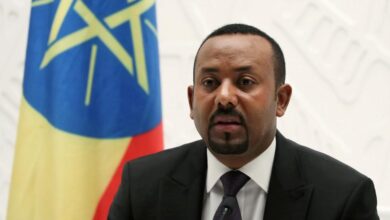
Ethiopian Government Slams Two Major Aid Organizations For Halting Aid
The Ethiopian government has criticized two major international aid organizations to stop food assistance to the country after they found…
Read More » -
Ethiopia

UN Food Agency Suspends Part Of Its Food Aid To Ethiopia Due To Diversions
The United Nations (UN) World Food Programme (WFP) on Friday announced that it has decided to suspend part of its…
Read More » -
Ethiopia
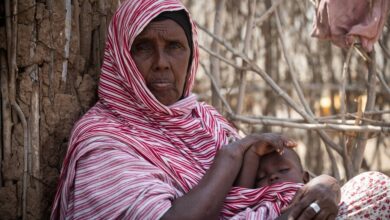
Ethiopian Government Rejects HRW Report On Ethnic Cleansing In War-Torn Tigray
The Ethiopian government on Tuesday rejected accusations by Human Rights Watch (HRW) that alleges that an ethnic cleansing campaign is…
Read More » -
Egypt
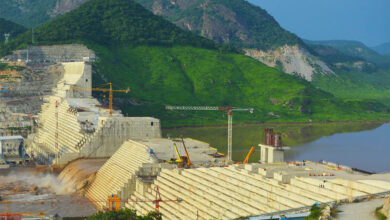
Egypt Confirms No Legally Binding Deal With Ethiopia On Nile Dam Filling
Egypt has rejected claims made by Ethiopia that an agreement has been reached on the period of filling of the…
Read More » -
Ethiopia
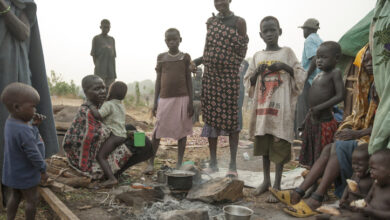
UN Receives Pledges Of $2.4 Billion To Support Drought-Affected People In Horn of Africa
The United Nations (UN) on Wednesday announced it has received pledges of $2.4 billion to fund aid operations for some…
Read More » -
Ethiopia
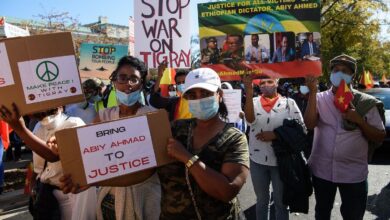
Ethiopians Protest In War-Torn Tigray To Demand Withdrawal Of Outside Forces
Ethiopians came out on the streets in large numbers in the war-torn Tigray region on Tuesday to demand the withdrawal…
Read More » -
Ethiopia

USAID Pauses Food Aid To Ethiopia’s Tigray Amid Claims Aid Is Being Diverted
The United States Agency for International Development (USAID) on Wednesday announced that it has decided to cease food aid to…
Read More » -
Ethiopia
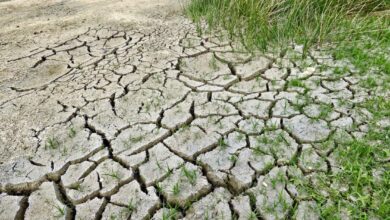
Drought In The Horn Of Africa Made Worse By Climate Change- WWA Study
The drought in the Horn of Africa has been made worse by human-induced climate change, according to a new report…
Read More » -
Egypt

Ethiopian Foreign Ministry Ready To Resume Nile Dam Tripartite Negotiations
The Ethiopian Foreign Ministry has said that it is willing to resume tripartite negotiations with Egypt and Sudan to resolve…
Read More » -
Ethiopia
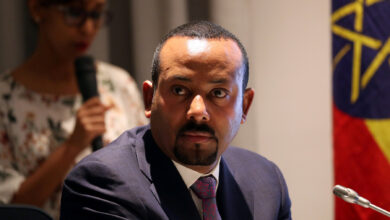
Ethiopian PM Says Government To Begin Negotiations With OLA Rebel Group
Ethiopian Prime Minister Abiy Ahmed on Sunday said the government would begin talks with the Oromo Liberation Army (OLA) in…
Read More » -
Ethiopia
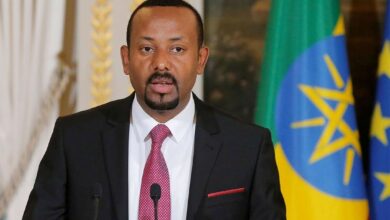
Ethiopian PM Abiy Ahmed Refuses Allegations Of Military Incursion Into Sudan
Ethiopian Prime Minister Abiy Ahmed on Thursday denied allegations that the Ethiopian military had entered the disputed Al Fashaqa region…
Read More » -
Ethiopia

Ethiopian Prime Minister Abiy Ahmed Vows To Dissolve & Reintegrate Regional Forces
Ethiopian Prime Minister Abiy Ahmed on Sunday vowed to dissolve and reintegrate regional forces established by some states, reported The…
Read More » -
Ethiopia

Ethiopia Announces 90 Percent Completion Of Controversial GERD Construction
Ethiopia on Thursday announced the construction work of the mega-controversial Grand Ethiopian Renaissance Dam (GERD) is 90 percent completed, reported…
Read More » -
Ethiopia

Ethiopian PM Ahmed Appoints Rebel Leader To Head Regional Government
Ethiopian Prime Minister Abiy Ahmed on Thursday announced the appointment of a Tigrayan rebel figure to head the interim government…
Read More » -
Ethiopia
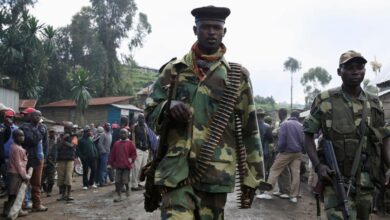
Ethiopian Parliament Removes Tigray Rebel Party From Terrorist Organizations List
Ethiopian lawmakers on Wednesday removed Tigray’s main political movement, the Tigray Peoples Liberation Front (TPLF), from the country’s list of…
Read More » -
Ethiopia
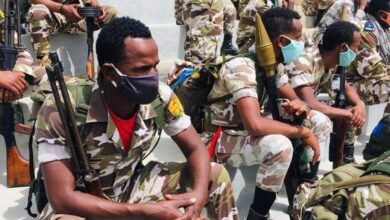
US Says All Warring Sides Committed War Crimes During Two-Year-Long Ethiopia Conflict
The United States (US) has concluded that all warring parties involved in the brutal war including the Ethiopian and Eritrean…
Read More » -
Ethiopia

US Secretary Of State Antony Blinken Announces $331 Million In New Aid To Ethiopia
The United States (US) Secretary of State Antony Blinken on Wednesday announced more than $331 million in new humanitarian aid…
Read More » -
Ethiopia

Amnesty International Calls On Ethiopian Authorities To End Social Media Blockout
Amnesty International, on Thursday, appealed to Ethiopian authorities to restore access to social media networks including Facebook, TikTok, and YouTube…
Read More » -
Ethiopia

Drought Trends In Horn Of Africa Worse Than 2011 Famine- IGAD Climate Center Claims
Drought trends in the Horn of Africa are now worse than the conditions experienced during the 2011 famine in which…
Read More » -
Ethiopia

Ethiopian Government Sends Funds To Restart Banking Services In Conflict-Hit Tigray
The Ethiopian government will reportedly send more than $90 million to the Tigrayan capital to help restart banking services in…
Read More » -
Ethiopia
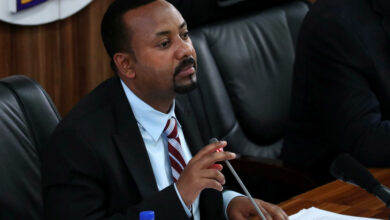
Ethiopian PM Meets Tigrayan Leaders First Time Since Signing Of Peace Deal
Ethiopian Prime Minister Abiy Ahmed on Friday met with Tigrayan leaders for the first time since the two factions agreed…
Read More » -
Ethiopia
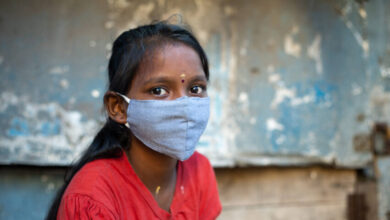
UN Organization Says 3.5 Million Children Don’t Have Access To School Across Ethiopia
The United Nations (UN) children welfare agency on Thursday said over 3.5 million children do not have access to school…
Read More » -
Ethiopia

Ethiopian Prime Minister Abiy Ahmed Visits Sudan On First Visit Since 2020 Coup
Ethiopian Prime Minister Abiy Ahmed on Thursday visited Sudan, his first trip to the neighboring country since a 2021 military…
Read More » -
Ethiopia

AU Mediator: War In Ethiopia’s Tigray Region May Have Killed 600,000 People
The African Union (AU) mediator in Ethiopia’s Tigray conflict, Olusegun Obasanjo, claims up to 600,000 people may have lost their…
Read More » -
Ethiopia
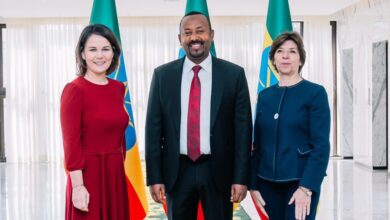
Foreign Ministers Of France And Germany Hail Success In Ethiopia Peace Deal
Foreign ministers of France and Germany on Thursday hailed the success in implementing a peace agreement signed last year to…
Read More »

